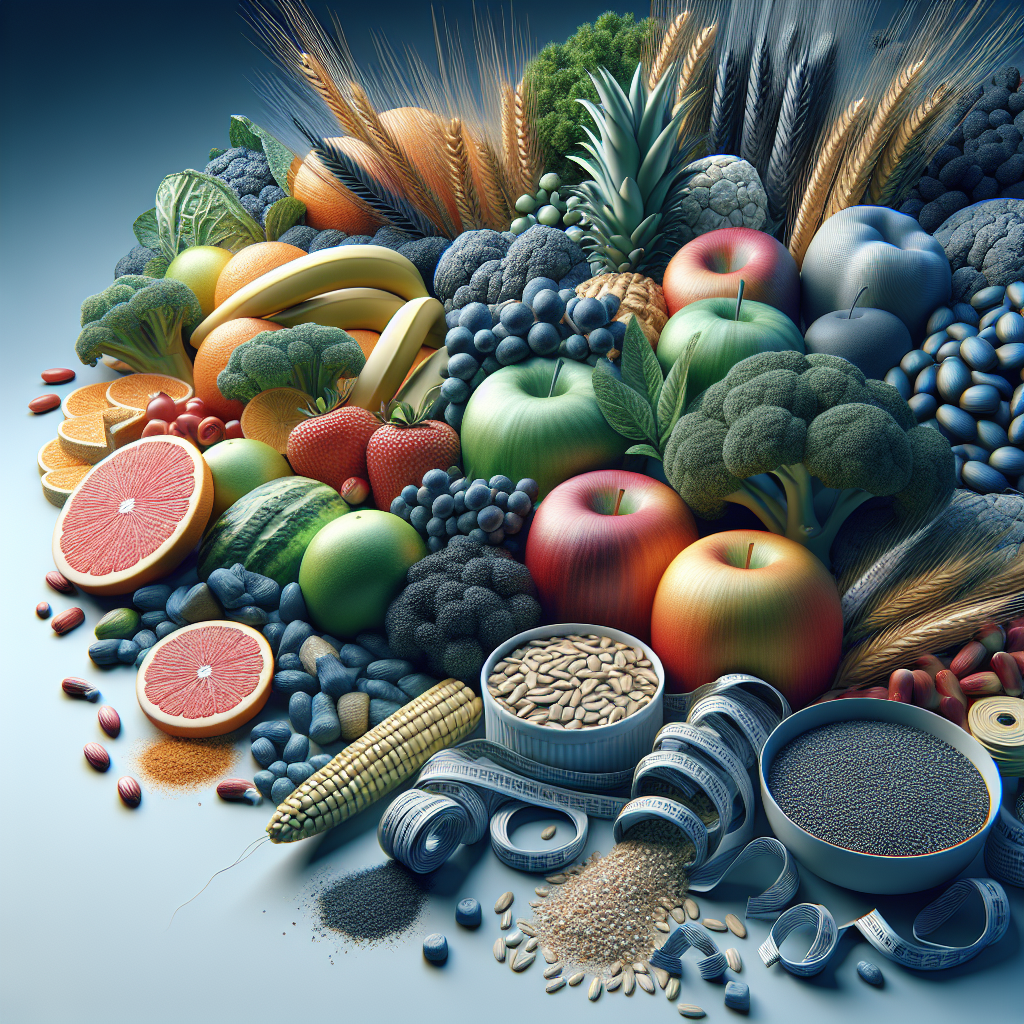Incorporating fiber into your diet offers numerous health benefits, including improved digestion, enhanced heart health, and better weight management, among others. A fiber-rich diet can lead to reduced risk of chronic diseases and contribute to overall wellness. Understanding the advantages of these foods is essential for making informed dietary choices that can have a lasting positive impact on your health.
Understanding Fiber: A Quick Overview
While we won’t delve into a definition of fiber-rich foods, it is crucial to recognize the types of dietary fiber—soluble and insoluble. Soluble fiber dissolves in water, forming a gel-like substance that can slow digestion. It’s found in foods such as oats, nuts, beans, lentils, and some fruits. Insoluble fiber, on the other hand, does not dissolve in water and helps add bulk to stools, promoting regular bowel movements. It’s present in whole grains, wheat bran, and vegetables.
The Importance of Dietary Fiber
Dietary fiber is a vital component of a healthy diet, bringing along numerous physiological benefits. Let’s explore these benefits in detail:
1. Enhanced Digestive Health
Regular Bowel Movements
One of the primary benefits of dietary fiber is its ability to promote regular bowel movements. High-fiber foods add bulk to the stool, making it easier to pass. This can significantly reduce the chances of constipation, a common digestive issue.
A study published in The American Journal of Gastroenterology found that individuals who consume a high-fiber diet experience fewer bouts of constipation and improved stool frequency compared to those who do not.
Types of Fiber That Aid Digestion
- Insoluble Fiber: Found in whole grains, nuts, and vegetables, it helps move food through the digestive tract.
- Soluble Fiber: Found in oats, apples, and beans, it can help manage the body’s water balance, preventing diarrhea.
Prevention of Diverticulitis
A high-fiber diet can lower the risk of diverticulitis—a condition characterized by inflammation of the diverticula in the colon. The 2019 study in the BMJ revealed that individuals consuming 25 grams of fiber daily had a 30% lower risk of developing diverticulitis.
Gut Microbiota Modulation
Dietary fiber acts as a prebiotic, fostering the growth of beneficial gut bacteria. A diverse gut microbiome is crucial for overall health, influencing everything from digestion to mental health.
- Health Effects of a Healthy Gut Microbiome:
- Improved immunity
- Better digestion
- Lower risk of chronic illnesses
Additional Insights
To maintain optimal digestive health, aim for a daily intake of 25-30 grams of fiber. Include a variety of fiber sources, such as fruits, vegetables, whole grains, and legumes.
2. Heart Health Improvement
Cholesterol Management
Soluble fiber can help reduce levels of LDL (“bad”) cholesterol. By binding to cholesterol molecules in the gut, fiber helps prevent their absorption into the bloodstream. The American Heart Association suggests that including fiber-rich foods can lower total cholesterol levels by 10-15%.
Foods High in Soluble Fiber
- Oats
- Barley
- Beans
- Lentils
- Apples
Blood Pressure Regulation
Several studies point to a correlation between a high-fiber diet and lower blood pressure. For instance, a meta-analysis published in the Journal of Hypertension indicated that individuals with a higher fiber intake experience reduced systolic and diastolic blood pressure.
3. Weight Management
Increase in Satiety
Fiber is a natural appetite suppressant. The presence of fiber in meals slows down digestion, keeping you fuller for longer periods. A study published in Appetite reveals that high-fiber meals can decrease hunger levels and overall calorie intake.
How to Incorporate Fiber in Your Meals
- Start with Breakfast: Opt for oatmeal or whole grain cereals.
- Snack Smart: Choose fruits, nuts, or popcorn as healthy snack options.
- Fill Your Plate: Ensure half of your meals consist of vegetables and whole grains.
Reducing Caloric Intake
Not only does fiber help you feel full, but it can also help manage caloric intake. Foods high in fiber are often lower in calories and nutrient-dense, which aids weight loss.
- Weight Loss Dietary Sources:
- Chia seeds: 10 grams of fiber per ounce
- Avocado: 9 grams of fiber per medium avocado
- Black beans: 15 grams of fiber per cup cooked
Supporting Healthy Metabolism
Incorporating fiber-rich foods into your diet positively affects your metabolism. Research indicates that those on high-fiber diets often have improved glucose metabolism, supporting weight management goals.
4. Reduced Risk of Chronic Diseases
Type 2 Diabetes Prevention
A high-fiber diet may lower the risk of developing type 2 diabetes. Soluble fiber helps improve insulin sensitivity by slowing the absorption of sugar into the bloodstream. The Journal of Nutrition published a study in 2020 that concluded individuals consuming more than 25 grams of fiber daily had a 20-30% reduction in diabetes risk.
Cancer Prevention
Epidemiologic studies show that a fiber-rich diet is associated with a decreased risk of several types of cancer, particularly colorectal cancer. A Cochrane Review highlighted that individuals with higher fiber consumption had a significantly lower risk of colorectal cancer.
Heart Disease Risk
Aside from lowering cholesterol levels, a fiber-rich diet could improve overall heart health, contributing to lower risks of heart disease. According to the Harvard School of Public Health, every 10 grams of fiber consumed daily is correlated with a 14% reduced risk of coronary heart disease.
5. Improved Blood Sugar Levels
Regulation of Blood Glucose
Fiber, particularly soluble fiber, can slow down glucose absorption, contributing to better blood sugar management in individuals with diabetes. The American Diabetes Association advises incorporating fiber-rich foods to improve glycemic control.
Recommendations for Diabetic Patients
- Whole Grains: Opt for whole-grain bread over white bread.
- Legumes: Beans and lentils are low in glycemic index and high in fiber.
| Fiber Type | Food Example | Fiber Content (grams) per 100g |
|---|---|---|
| Soluble Fiber | Oats | 10 |
| Soluble Fiber | Chia seeds | 34 |
| Insoluble Fiber | Wheat bran | 43 |
| Insoluble Fiber | Broccoli | 2.6 |
6. Enhanced Skin Health
Detoxification
Certain dietary fibers assist the body in detoxification processes, eliminating toxins through bowel movements. This can lead to clearer skin and a healthier complexion.
Inflammation Reduction
Incorporating more fiber may help decrease inflammation in the body, which in turn can benefit skin conditions like acne or psoriasis.
7. Mental Health Benefits
Gut-Brain Connection
Emerging research illustrates the connection between gut health and mental well-being, often referred to as the gut-brain axis. A fiber-rich diet supporting a healthy gut microbiome may play a role in alleviating symptoms of depression and anxiety.
Stress Reduction
Certain fibers promote the production of short-chain fatty acids (SCFAs) during digestion, which have been linked to reduced stress and anxiety levels.
Practical Tips for Enhancing Mental Health Through Diet
- Incorporate probiotic-rich foods: Consider yogurt or fermented products alongside fiber-rich foods to support gut health.
- Mindful Eating: Focus on your meals and avoid distractions while eating, enhancing the digestive process and mental engagement.
8. Practical Ways to Increase Fiber Intake
Gradual Incorporation
If you’re not accustomed to a high-fiber diet, it’s important to increase fiber intake gradually to avoid digestive discomfort.
- Start with Breakfast: Choose a fiber-rich cereal or oatmeal.
- Smart Snacking: Opt for fruits, vegetables, or nuts instead of processed snacks.
- Diverse Meals: Introduce new fiber sources such as quinoa, lentils, or whole grain pasta.
Cooking Tips
- Add Beans: Incorporate beans into salads, stews, and casseroles.
- Sneak in Vegetables: Add extra vegetables to sauces, omelets, or smoothies.
- Choose Whole Grains: Always look for whole grain or whole wheat options for pasta, bread, and rice.
Monitoring Fiber Intake
Keep a food diary to track your fiber intake. There are various apps available that can help you calculate dietary fiber consumption effectively.
Conclusion: Embracing a Fiber-Rich Diet for Lifelong Health
Incorporating fiber-rich foods into your daily diet not only enhances digestion but also strengthens heart health, aids in weight management, and reduces the risk of chronic diseases. Whether through fruits, vegetables, whole grains, or legumes, a diversified and balanced intake of fiber is paramount to achieving these benefits.
As you create your meal plans and grocery lists, remember the practical tips and evidence-backed recommendations provided throughout this article. Your journey to optimal health through a fiber-rich diet starts with small, manageable changes. Gradually increasing your fiber intake can unlock a plethora of health benefits, contributing significantly to your overall well-being and longevity.
For the best results, aim for a balanced diet rich in a variety of fibrous foods and consult with a healthcare professional or a registered dietitian regarding personalized dietary changes. By making informed choices today, you can pave the way for a healthier tomorrow.











